Five famous missiles of the Soviet Union
The atomic bombing of Hiroshima 6 August 1945, the year forever divided the twentieth century, and with it all history of humanity into two unequal epochs so far: pre-nuclear and nuclear. The second symbol, alas, was precisely the nuclear mushroom, and by no means the silhouette of the nuclear power plant (although the largest number of fissile materials is used today in peaceful industries). And the main means of delivery were missiles - from operational-tactical to intercontinental ballistic.
Rocket weapon it was not a product of the twentieth century: the idea to use crackers for military purposes came up with Chinese inventors a good millennium earlier. And the century before last was the time of large-scale rocket experiments. For example, 30 March 1826 of the year in St. Petersburg, through the efforts of one of the Russian pioneers of the rocket business - Major General Alexander Zasyadko - opened the Rocket Launcher, which became Russia's first industrial production of combat missiles. A year later, on the order of the same Zasyadko, the first permanent rocket company in Russia was created, armed with 18 machines for 20-pound, 12-pound and 6-pound rockets.
However, it took completely new technologies and completely new sciences such as aerodynamics to turn rockets from exotic weapons into mass ones. And in this process, Russia, despite the social cataclysms that shook it, remained at the forefront: Soviet "Katyushas" became worthy heirs of the Zasyadko rocket companies. So it is completely natural that the world's first nuclear warhead missile and intercontinental ballistic missile, like the space launch vehicle, were created in Russia. Just as the world's most powerful intercontinental ballistic missile R-36M, which earned the gloomy name “Satan” in the West. The last of the combat versions of this rocket, the P-36М2 "Voevoda", was on combat duty on July 30, 1988, and continues to serve to this day. About it and about five other famous Soviet military missiles today and tells the "Historian".
Р-5М - THE FIRST IN THE WORLD OF A ROCKET WITH A NUCLEAR LEAGUE
Type: medium-range ballistic missile
Number of steps: one
Maximum range: 1200 km
Warhead Weight: 1350 kg
The number and power of combat units: 1 × 0,3 or 1 MT (Р-5М)
Adopted: 1956 year
Out of service: 1964 year
Units, total: 48
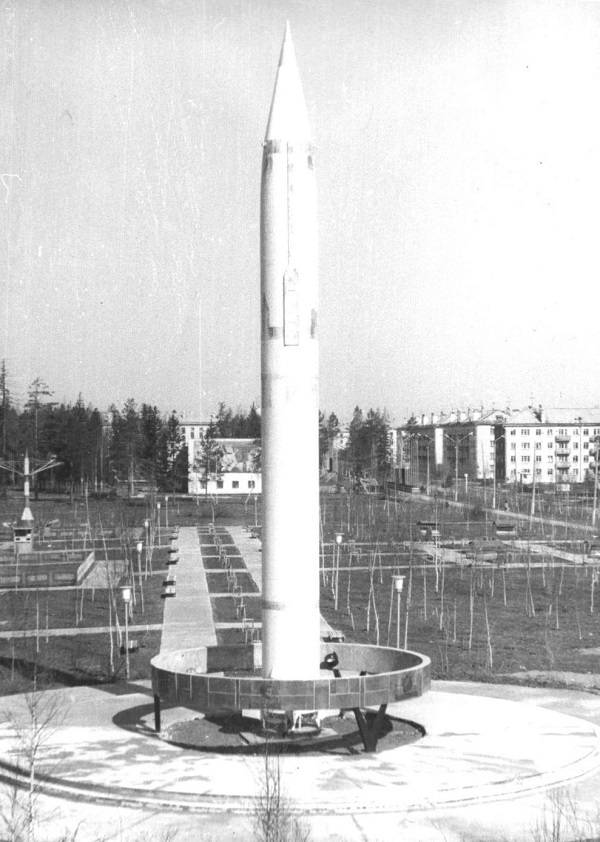
Rocket R-5M in the park named after Hero of the Soviet Union, Lieutenant General Galaktion Alpaidze in the town of Mirny
February 2 In the Soviet Union, 1956 conducted the “Baikal” operation, about which there were no reports either by radio or in print. She was not worried about the intelligence services of the likely enemy: yes, they noted that a nuclear explosion with a capacity of up to 80 kilotons was made on Soviet territory, but they considered this a routine test. Meanwhile, this explosion marked the beginning of a completely different time: at a distance of 1200 km from the test site, Kapustin Yar hit the target and the world's first nuclear warhead of a ballistic missile worked.
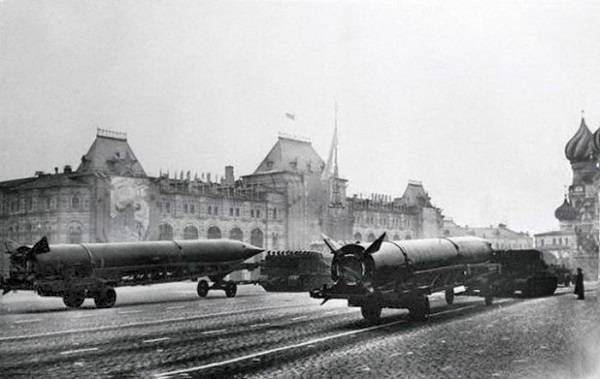
P-5M rockets on parade in Moscow 7 November 1957 of the year
With the advent of the world's first nuclear warhead missile, two noteworthy abbrevitatures are connected — RDS and GIF. The first one had the official transcript of the “Special Jet Engine” and the unofficial “Russia Does Itself”, and in practice these special letters hid nuclear special ammunition. The second abbreviation was interpreted as “Long-Range Atomic Rocket” and meant what it meant: a modification of the P-5 ballistic missile capable of carrying special weapons. It took more than two years to develop it, and soon the world's first nuclear-powered missile was successfully tested. Academician Boris Chertok described them best and shortest in the memoirs “Missiles and People”: “The launch was completed without any overlays. The R-5M rocket for the first time in the world carried the atomic charge through the space. Having flown the laid 1200 km, the head reached Earth in the area of the Aral Karakum without destruction. The shock fuse worked, and the terrestrial nuclear explosion marked the beginning of the nuclear-missile era in the history of mankind. No publications about this historical event followed. American technology had no means of detecting missile launches. Therefore, the fact of the atomic explosion was noted by them as another ground test of atomic weapons. We congratulated each other and destroyed the entire supply of champagne, which had previously been carefully guarded in the canteen of the management staff. ”
Р-7 - THE FIRST IN THE WORLD INTERCONTINENTAL BALLISTIC ROCKET
Type: intercontinental ballistic missile
Number of steps: two
Maximum range: 8000 – 9500 km
Head Weight: 3700 kg
The number and power of combat units: 1 x 3 MT
Adopted: 1960 year
Out of service: 1968 year
Units, total: 30 – 50 (estimated data; only combat modifications of P-7 and P-7А)
The launch of the P-7 rocket from one of the starting positions at the Baikonur test site, the end of 1950-x
The P-7 intercontinental ballistic missile, oddly enough, is known to everyone who at least once saw on the screen or live launch of Vostok or Soyuz space rockets and their later modifications. Just because all the launch vehicles of this type are nothing but variations of the very same G-7, which was the world's first intercontinental ballistic missile. On its first flight of the P-7, 15 went on May 1957, and no one knows when the last one will take place.
The first document that formulated the requirements for the R-7 rocket was a top secret resolution of the Council of Ministers of the USSR "On the plan of research work on long-range missiles for 1953-1955", adopted on February 13, 1953. The second paragraph of this document determined that the future "seven" should have the following characteristics: "The greatest sighting range: at least 8000 km; maximum deviation from the target at the maximum aiming flight range: in range - +15 km <…>, in the lateral direction - ± 15 km; warhead weight not less than 3000 kg. " A little over a year later, another secret resolution of the Central Committee of the CPSU and the Council of Ministers of the USSR No. 956-408ss "On the creation of a rocket for a payload of 5,5 tons, with a range of at least 8000 km" appeared, which already featured the missile index - R-7.
P-7 missile transported to a combat position
The Seven became a long-lived rocket, but only in the area of space launches: as a combat rocket, it was not very successful. Too much time - from two to eight hours - was required to prepare it for launch. This process was too time consuming and expensive, and the associated costs were too high: in fact, each combat position required its own oxygen plant, which provided the missiles with fuel. As a result, the P-7 and its more powerful version of the P-7A stood in service for only eight years, and even at the peak of their deployment, only six sites carried combat duty: four in Plesetsk and two in Baikonur. At the same time, the G-7 played its colossal role in politics: when the United States and its allies learned that the USSR possesses a full-fledged intercontinental ballistic missile, this news chilled even the hottest hawks.
Р-11 - THE FIRST SOVIET OPERATIONAL TACTICAL ROCKET
Type: ground-based tactical missile
Number of steps: one
Maximum range: 150 km
Warhead Weight: 950 kg
The number and power of combat units: 1 x 10, 20 or 40 Mt
Adopted: 1955 year
Out of service: 1967 year
Units, total: 2500 (according to foreign data)
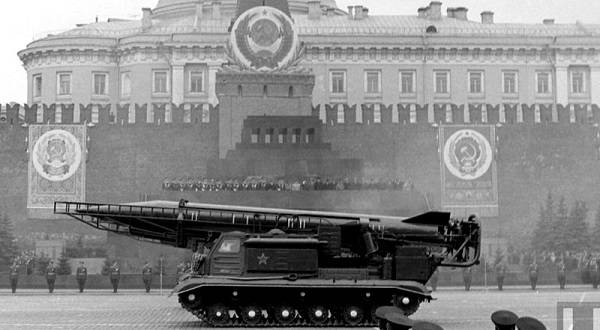
P-11 missiles on self-propelled launchers during a parade in Moscow
One of the most famous Soviet missiles outside the USSR were the Scuds, that is, Squall. By this characteristic and a lot of what the talking title, as a rule, means mobile missile systems with the P-17 rocket, which have received the widest distribution and have glorified the Soviet rocket scientists. However, for the first time, this code name in the West was given to the P-11 rocket, which was the first domestic operational-tactical missile with a nuclear warhead. And it also became the first Soviet sea-based missile, "registering" on the submarines of the AB-611 project and the first specialized submarine-launched missile carriers of the 629 project.
P-11 is the first not only in this: it was also the first domestic rocket on high-boiling fuel components, in other words, on kerosene and nitric acid. According to the theory prevailing at the time, such fuel was suitable only for medium and short range ballistic missiles (although it later became clear that intercontinental missiles also fly perfectly on it). And, while Sergei Korolev brought the "oxygen" P-7, his subordinates designed and brought the "acid" P-11. When the rocket was actually ready, it turned out that it could not only be stored for a long time in a filled state, but also be made mobile, loaded onto a self-propelled chassis. But it was not far from here that the P-11 was placed on a submarine, because until then all the rockets required only ground-based launch sites with a complex and extensive infrastructure.
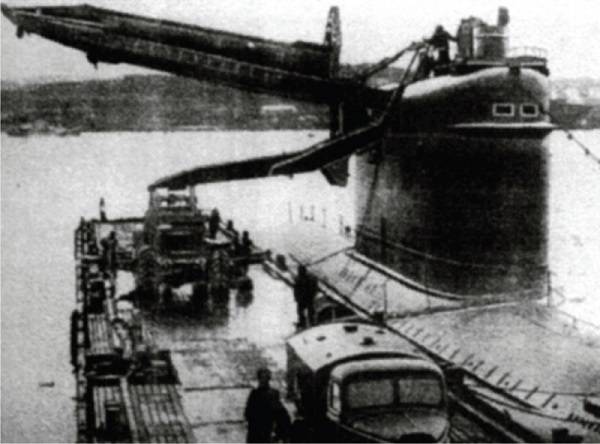
Loading naval modifications of the R-11 - R-11FM missile to the project AB611 submarine
The first flight of the P-11 rocket took place on 18 on April 1953, and two years later it was commissioned by the Soviet army as part of a complex consisting of the rocket itself and a self-propelled tracked chassis. As for the naval modification of the P-11FM, it set out on the first flight from the submarine B-67 on the evening of 16 on September 1955 of the year, and was put into service on the 1959 of the year. Both modifications of the P-11 - both sea and land - served not for long, although they became an important stage in the development of domestic rocket weapons, allowing its creators to accumulate the most valuable and most important experience.
UR-100 - THE FIRST LARGE-SERIAL INTERCONTINENTAL BALLISTIAN ROCKET OF THE USSR
Type: intercontinental ballistic missile
Number of steps: two
Maximum range: 5000 – 10 600 km
Warhead weight: 760 – 1500 kg
The number and power of combat units: 1 x 0,5 or 1,1 MT
Adopted: 1967 year
Out of service: 1994 year
Units, total: at least 1060 (with all modifications)
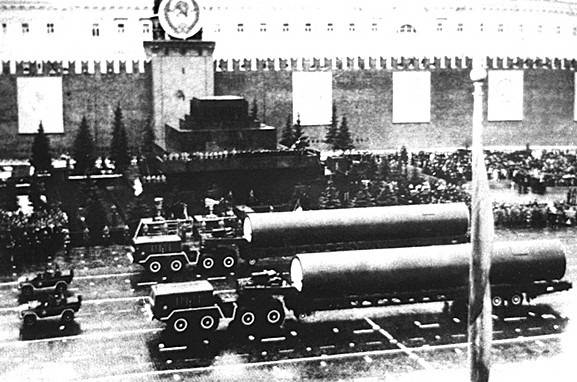
Ampoules with UR-100 missiles at the November parade
The UR-100 rocket and its modifications were landmark for the Soviet rocket industry and the Strategic Missile Forces. “Sotka” was the first large-scale intercontinental ballistic missile in the USSR, the first missile that became the basis of the ballistic missile complex built on the principle of a “separate start”, and the first ampullar missile, that is, one that was fully assembled and refueled at the plant, was also located there the transport and launch container in which it was lowered into the silo launcher and in which she was on duty. This allowed the UR-100 to have the smallest preparation time to launch among the Soviet missiles of that period — just three minutes.
The reason for the appearance of the UR-100 missile and the missile complex based on it was the substantial superiority of the United States in intercontinental ballistic missiles, which arose by the beginning. Xnumx's. As of 1960 March 30 of the year, that is, by the day of the official commencement of the development of "hundreds", in the Soviet Union only 1963 intercontinental ballistic missiles were on combat duty — one and a half times less than in America. In addition, two-thirds of American missiles had silo launchers, and all domestic were open, that is very vulnerable. Finally, the main threat was represented by the American LGM-56 Minuteman-30 solid-fuel two-stage rocket: their deployment went an order of magnitude faster, and this could force the US leadership to abandon the doctrine of a retaliatory nuclear strike in favor of a preventive one. Therefore, the USSR was required to get a rocket, which would allow in the shortest possible time to reduce the backlog, and even create an advantage in their favor.
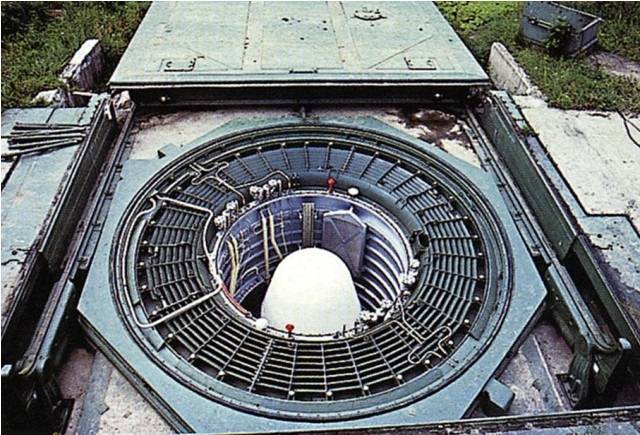
View of the head of the missile UR-100, housed in a silo launcher
Such a missile and became the UR-100. She was born as a result of a contest between two famous designers - Mikhail Yangel and Vladimir Chelomey. For a number of reasons (including very personal), the political leadership of the USSR chose the Chelomey design bureau, and in two years - from 1965 to 1967 - weaving went all the way from the first test launches to the launch. The rocket turned out to be with a large modernization reserve, which made it possible to improve it for almost three decades, and fully fulfilled its mission: its group, deployed in the shortest possible time, fully restored Soviet-American missile parity.
Р-36М - THE MOST POWERFUL BALLISTIC ROCKET IN THE WORLD
Type: ground-based intercontinental ballistic missile
Number of steps: two (plus a dilution unit for later modifications)
Maximum range: 10 200 – 16 000 km
Head Weight: 5700 – 8800 kg
The number and power of combat units: 1 x 25 Mt, or 1 x 8 Mt, or 10 x 0,4 Mt, or 8 x 1 Mt, or 10 x 1 Mt
Adopted: 1975 year
Out of service: on duty
Units, total: 500
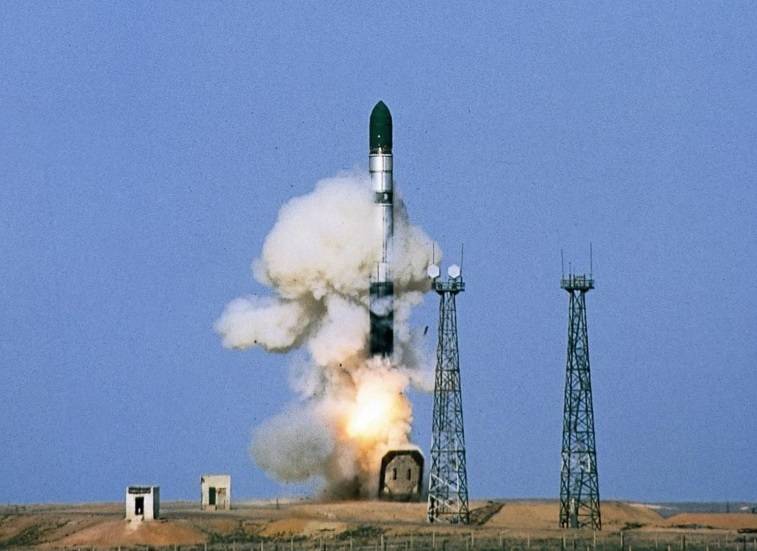
Launch of the P-36M rocket from the silo launcher
A remarkable fact: the P-36 rocket, which was the predecessor of the thirty-sixth family, was called the main task facing the Design Bureau of Mikhail Yangel at the same meeting at the OKlev-52 branch office, where the fate of SD-100 was decided. True, if the "weaving" was considered a light rocket and had to take, so to speak, a number, then the "thirty-sixth" was considered a mass. In the literal sense of the word: this rocket is the heaviest intercontinental ballistic rocket in the world, both in terms of the mass of the combat charge being thrown and in terms of the total starting weight, which in the latest modifications reaches 211 tons.
In the first P-36, the starting weight was more modest: “total” 183 – 184 t. The front end equipment turned out to be more modest: drop weight - from 4 to 5,5 t, power - from 6,9 (in a divided warhead) to 20 Mt. These missiles did not last long in service, only until the 1979 year, when they were replaced by the R-36M. And the difference in attitude towards these two rockets is clearly visible by their code names, which were given to NATO. The P-36 was called Scarp, that is, Escarp, the anti-tank obstacle, and its successor, P-36M and its entire family, Satan, that is, Satan.
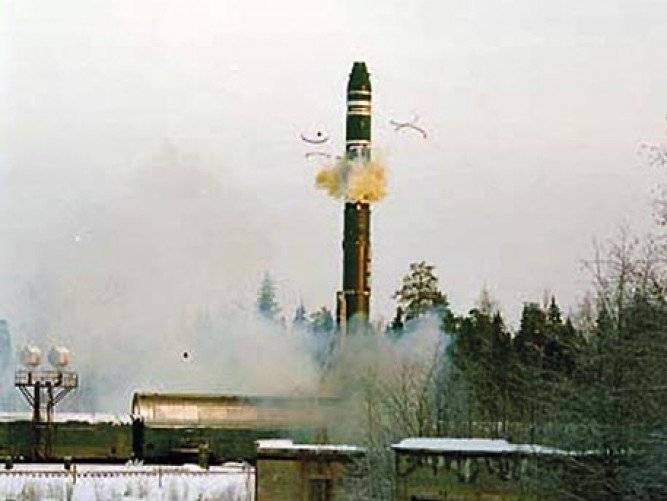
Rocket R-36М2 "Voevoda" starts with one of the combat positions of the 13-th missile Orenburg Red Banner RVSN division
P-36M received all the best from its progenitor plus the most advanced materials and technical solutions that were available at that time. As a result, it was three times more accurate, its combat readiness was four times higher, and the degree of security of the launcher increased by orders of magnitude - from 15 to 30 times! This was, perhaps, no less important than the weight of the bombardment and its power. After all, to the second floor. 1970-x, it became clear that one of the most important goals for missiles - the missiles themselves, or rather, their starting positions, and those who manage to create a more protected one will eventually gain an advantage over the enemy.
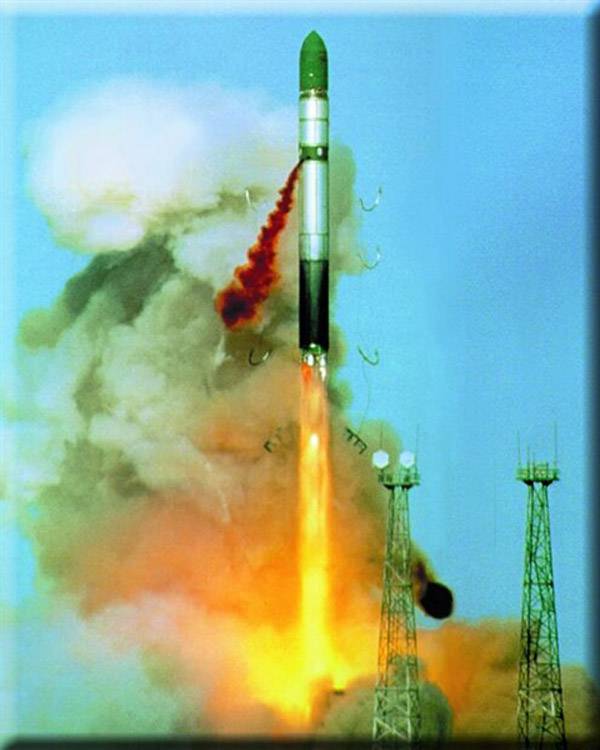
"Voevoda" starts from the ground
As of today, the most modern modification of the Р-36М - Р-36М2 "Voevoda" is in service with the Russian Rocket Forces of strategic purpose. The service life of this complex was extended not so long ago, and it will remain in service at least until 2022 of the year, and by that time it should be replaced by a new one - with the fifth-generation intercontinental ballistic missile PC-28 Sarmat.
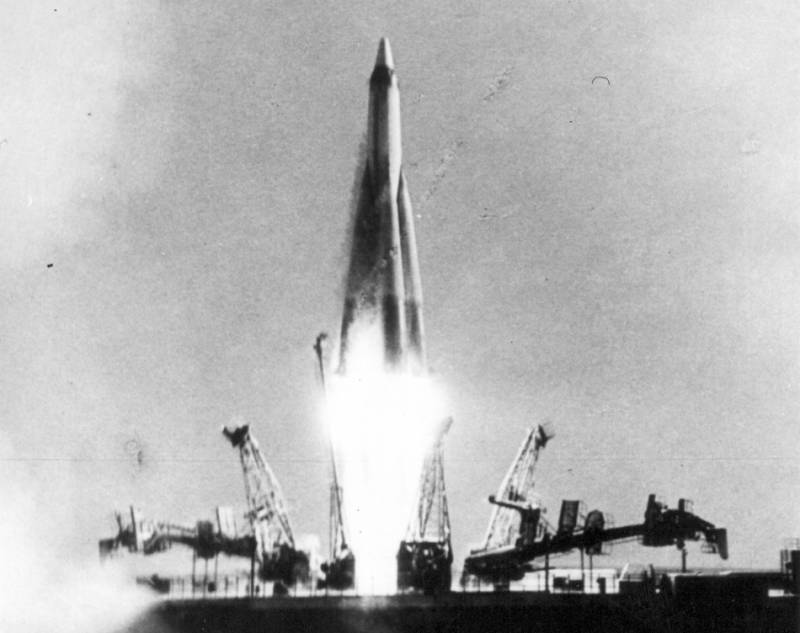
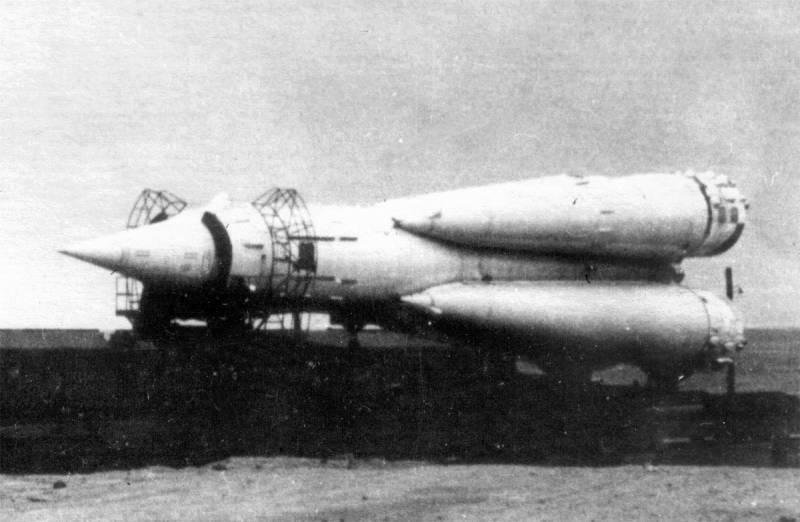
Information